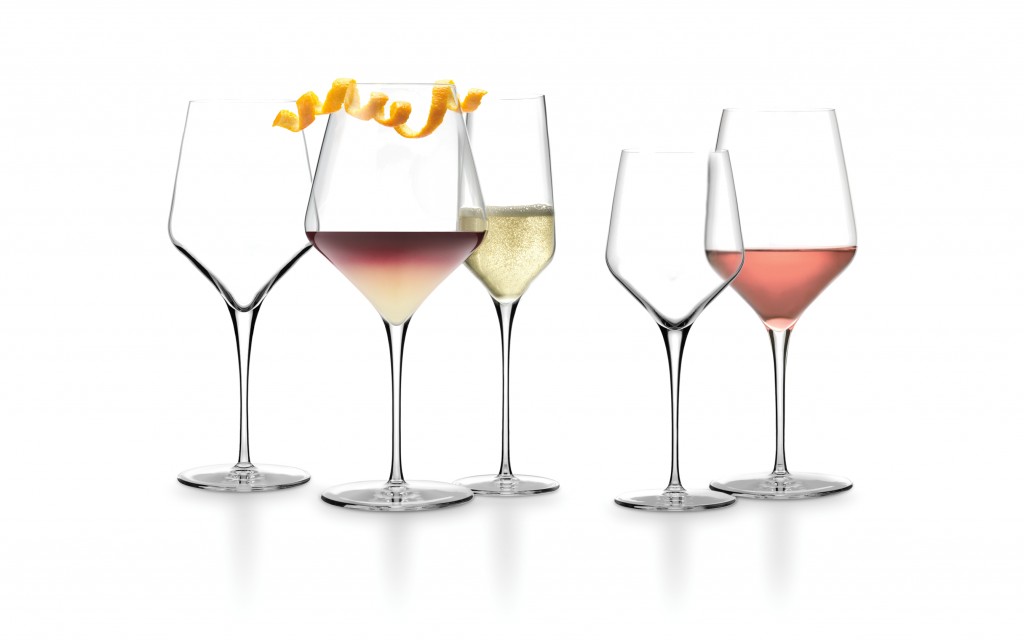
Whether red or white, sweet or dry, full-bodied or light, wine requires specific serving procedures in order to tap into the full potential that it has to offer. Understanding the different types of glassware and how they complement your wine will help amplify your overall wine drinking experience! Welcome to Wine Glasses 101.
Parts of a Wine Glass
The Foot: Allows the wine glass to stand upright
The Stem: Allows you to hold the glass without warming the wine up. If you were to hold the glass by the bowl, the wine would start warming up due to the body heat coming from your hands. While this may not be as big of a deal for red wines (as they are typically served at room temperature), it is probably not the best idea for a chilled white wine or champagne. Warming the glass could change the flavor of the wine
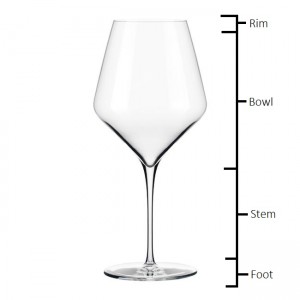
Image courtesy of Libbey®
The Bowl: Has numerous purposes; this is where you’ll find the most variation between glasses. The bowls of wine glasses are typically tapered upward with a slightly narrower opening at the top than at the bottom for proper swirling. The swirl is what releases the aroma compound of your wine. When you put the glass up to your nose after the swirl, you’ll notice a concentrated aroma coming directly from the glass. This allows for a better tasting wine and overall experience.
The bowls of wine glasses often differ in surface area depending on the type of wine you choose to drink. Red wines calls for a glass with a larger surface area to allow the wine to breathe, while white wine call for a glass with a smaller surface area. Champagne is served in a glass with a very small surface area, such as the flute, to allow the wine to retain its carbonation.
The Rim: The rim is where the flavor hits your palette first and serves a more important role than one would think. Mixologist Sandy Verma describes it best, “The rim is imperative to achieving the full experience from your wines. The thinner the rim, the less the glass distracts from the wine as you sip. A good wine glass will have a “cut” rim that is smooth to touch and does not inhibit the wine as it flows out of the glass. Less expensive glassware may have rims that are rolled or bumpy – while still functional, and very much practical for everyday use, these wine glasses may distract from the wine itself.”
Wine by the Glass
Red Wine
Red wines are best served in large wine glasses. The bowls of these glasses will be rounder and fuller with a larger opening than other wine glasses of similar capacities. This will allow you to dip your nose into the glass to detect the aroma through both taste and smell allowing for the best wine experience.
White Wine
A white wine glass will be slightly slimmer than that of a red wine glass; it will have more a U-shape to it. Less volume in the glass allows the wine to stay cooler longer while still letting the wine showcase its aroma. White wine glasses can have two types of openings – a slightly larger opening to direct the wine to the tip and sides of the tongue or a taller more narrow opening to direct the wine to the back of the tongue. The taller narrower opening is most applicable for more mature wines.
Sparkling Wine or Champagne
A sparkling wine glass will have the smallest volume of all the wine glass. This will allow the sparkling wine to retain its carbonation and temperature for a longer period of time helping the drinker capture the full flavor in the beverage. When you think of sparkling wine, think of flute glasses or coupe glasses
Rose Wine
Rose wines most commonly offer a medium-sweet taste to them but can also be very dry. Stemmed glasses with a short bowl that either have a tapered or a flared rim best compliment this wine. Tapered rims compliment a rose with a full-bodied flavor while flared rim enhances the sweetness of a lighter rose.
Pairings
Here are a few options for pairing wine with wine glasses from the Libbey® Masters Reserve® Collection, an American-made glassware collection presenting both elegance and style.
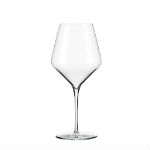
Prism 24 oz. Courtesy of Libbey®
Burgundy
Burgundy is a red wine which means it needs a larger bowl allowing for a nice swirl to release the aromas of the wine. This 24 oz. glass is ideal for a Burgundy wine. It also works well with a Pinot Noir or any other full-bodied wine.
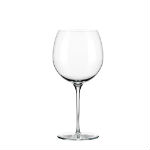
Renaissance 24 oz. Courtesy of Libbey®
Cabernet Sauvignon
Jerry Moore, a Libbey® glassware product manager says that this 24 oz. Renaissance glass is “perfect for Cabernet Sauvignon.” Stating, “It’s got a really wide bowl that helps with the evaporation and the aroma. This puts it more toward the back of the tongue.” Shiraz, Zinfandel, and Malbec are other red wines that also work well with this glass.
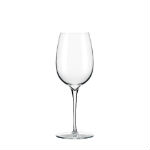
Renaissance 13 oz. Courtesy of Libbey®
Pinot Grigio
The 13 oz. Renaissance glass is best for a Pinot Grigio. It is wide enough to allow the wine to breathe while being small enough to keep the wine cool in temperature.
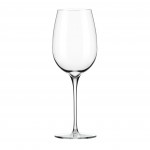
Courtesy of Libbey®
Chardonnay
A Chardonnay needs a slightly larger bowl than the Pinot to allow for more swirling to let the aroma to take precedence. However, the bowl should not be so big that the Chardonnay loses its cool temperature.

Prism 8 oz Flute. Courtesy of Libbey®
Champagne
This is where the flute glass comes to play. It has a long stem, narrow bowl, and tapered rim to allow the champagne to retain its carbonation and cool temperature for a longer period of time.


